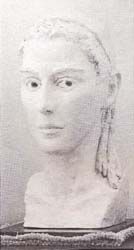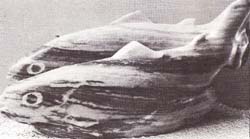The following is an intenriew with sculptor Nancy Green. Nancy has been a NWSSA member since 1992 and is currently membership chairman. She has been a teacher, artist, sculptor, and mother. Although "retired" from fulltime work, she has a fulltime schedule with her art work and assistance to NWSSA. I visited her at her home and studio in Seattle, Washington. The small home contains her art - both finished and in progress. She showed me her outdoor studio - a covered porch obtained with the help of Mary and Forest Hamilton, Jim Paget, Irene Hewins, and Nicki and Steve Oberholtzer and built by Steve. It contains a small work table. (Editor's note: Stephen Sandry will return to doing the interviews next issue)
Barbara Lynch: When did you began to do art work?
Nancy Green: I have been drawing and painting since the age of eight. I took my first life class at age twelve. I have drawn portraits since high school and done watercolors and landscapes.
BL: When and how did you begin sculpting?
NG: I took sculpture classes taught by Everett DuPen in 1946 and 1956. We worked with clay, wood and plaster casting. I did wood carving when I could.
BL: Was this the beginning of your interest in sculpture?
NG: No. When I was a child, I would do drawings of sculptures. I have always been interested in the human form
BL: Did you have exposure to art as a child?
NG: Yes, when I was eleven, my folks took me to New York to the art museum.
BL: What is your formal training besides the sculpture classes?
NG: I have a degree in art education. I graduated from the University of Washington in 1962. I also took art and anatomy there. I had wanted to be a medical illustrator, but it was not meant to be.
BL: Did you become an art teacher when you got your degree?
NG: No, I taught handicapped children. I did, however, use some of what I learned by having the kids do paper sculptures.
BL: What was your first job or sale doing sculpture?
NG: In New York City, I made two sets of teeth in wax for the Columbia University Dental School at five times normal size for them for teaching purposes.
BL: Have you worked on other projects that might be classed as teaching aids?
NG: For forty years I have worked off and on to carve a wooden skeleton to use to teach human anatomy to sculptors. This would be more fully articulated than medical school skeletons and would allow clay to be used on it to show muscles in various positions. Several years ago, I had access to some skeletons in the Anthropology Dept. at UW. I made several sketches to use for this project. The bones are being carved from boxwood. When I worked at Boeing doing drafting, I had a large french curve I used a lot. I realized this would be useful in doing a spine. That was how this project started.
BL: What sculpture are you currently working on?
NG: An African woman with a baby done in chlorite. My fish sculpture was recently on display at the Washington State Convention Center and has been entered in a juried show at Anacortes.
BL: What is your philosophy about sculpting?
NG: Understand the subject you are projecting in stone whether it is abstract or representational. Then you can visualize it in stone. Practice in any medium yon can.
BL: What is your approach to doing a sculpture?
NG: The first thing is roughing it out. This takes a long time. Then I refine it. It is important to pay attention to the parts that stick out. An example is the dorsal fin on the fish. I had to keep carving the fish down to have enough room for the dorsal fin.
BL: Do you do sketches before you begin the work?
NG: Yes, and sometimes I do a maquette such as a clay model.
BL: How do yon know when a piece is finished?
NG: WhenI am satisfied with it.
BL: Have you had pieces that you start that don't work for you and how do you deal with these?
NG: I have two friends who give me feed back. They can be more objective than I am when I am working the piece. I also put the piece away for awhile and am able to be I more objective when I later work on it.
BL: Do you have advice for begimting sculptors?
NG: Patience is a given. Also, different stones have different characteristics. Learn the unique characteristics of the stone you are using.
BL: How do you approach teaching?
NG: I respect that each person has a uniqne way of seeing things. I have them look at the thing they are sculPting from five sides including from the top.
BL: As a woman. do you see your approach to art as different than a man's.
NG: I think that women can do children better. Everett DuPen did wonderful children. He was an exception.
BL: Tell me about your bronze piece "Mother and Son."
NG: When I took sculpting from Everett DuPen, I remember working on a clay model and doing what I thonght was a fairly good piece. Everett looked at it, said okay, and then had me throw the clay back in the clay pile. We didn't save any of our work, but by the end of the quarter, "Mother and Son" done in clay was the result. I was a mother myself then and could understand a little of what being a mother meant. I later had the piece cast in bronze.
BL: Has this piece been entered in any shows?
NG: Yes, in the show that Patti McPhee organizes for the blind. Here is what the blind judge had to say about the piece: "This goes well together. I like the hand, and it all really works together - shoulders, face, everything. It is a person. I can tell it is a person. Everything works well. The lines are well formed, even the shapes work well together. It is a person, I know."
BL: Which sculptors most inspire yon?
NG: Michelangelo, Henry Moore, & Gaston Lachaise.
BL: Are there themes in your work?
NG: People and animals. Their structure and form. That has always fascinated me.
BL: You have worked in various media such as wood, clay, stone, and with painting. Have you had a time when the knowledge from these have come together to enhance a piece.
NG: It has enabled me to see the sameness of people. I can call a person with black skin "brother" because the bone and muscle structure are all basically the same for everyone. I have also learned to see better. For instance, all Chinese people don't look alike to me. My son had a Polynesian and an African girl friend. I could appreciate their beauty and I used them in some of my artwork.
(Nancy took me an a tour of her harne, showing me various pieces of her work)
NG: This was my first threedimensional piece. It is a bird done in juniper. And this girl in myrtlewood was an early piece that was in a show at Queen Anne. I know now that the proportions were not quite right. Proportions are so important. I wish they would have given me some feedback at the show.
BL: That is an interesting piece (pointing to a 2-1/2 foot carving). Tell me about it.
NG: It's a house post. We were doing some remodeling and on my family home on Queen Anne and replacing a section of post. So I carved it into a female nude in a dance pose. When we sold the house, I was able to take a part of my home with me.
BL: You have been active in the Association since you became a member in 1992. I know you are membership chairman and have helped with the newsletter. And I was at a workshop working with clay using a live model. You were teaching proportions and bone structure. Someone mentioned that you were involved in a show for Everett DuPen.
NG: I was working at the Frye Art Museum and suggested they have a show of Everett's work. Everett had had a show there some years before and it was well received Everybody agreed it was time for him to have a retrospective show. A group from the Association helped to gather and bring in the work. I later heard from several sources that it was the best show they ever had.
BL: Thanks, Nancy.

